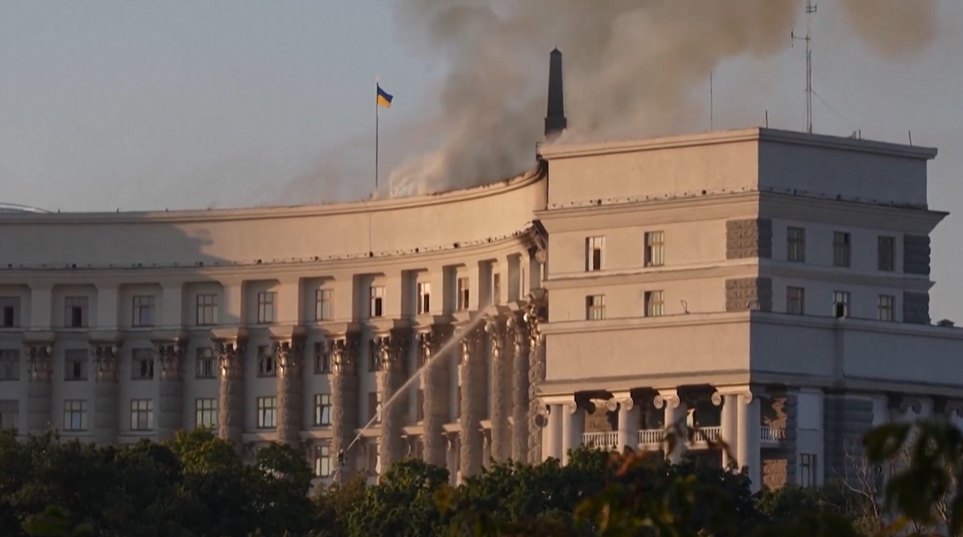Russia Launches Largest Air Attack of War, Strikes Ukrainian Government Building in Kyiv
On September 7, 2025, Russia carried out its largest aerial assault of the Ukraine war, deploying over 800 drones and, for the first time, striking a government building in Kyiv. The unprecedented attack killed at least four people across Ukraine, including an infant, and left 44 injured, according to President Volodymyr Zelensky. Air-raid sirens sounded in the capital for more than 11 hours as missiles and drones rained down on residential areas and critical infrastructure.

The Scale of the Assault
Ukraine’s Air Force reported that Russia launched 810 drones, four ballistic missiles, and nine cruise missiles during the overnight assault. While most were intercepted, 54 drones and nine missiles struck targets nationwide. The strike exceeded the scale of Moscow’s previous record assault in July, marking a dramatic escalation in the ongoing conflict. A government building housing the prime minister’s office and ministries sustained roof and upper-floor damage in Kyiv’s government quarter—an unprecedented move in the war.
Casualties and Damage
In Kyiv’s Sviatoshynskyi district, a nine-story residential building was severely damaged, with four floors partially destroyed. A young woman and an infant under the age of one were killed when rubble collapsed. Fires also broke out in multiple high-rise apartment complexes across the capital. Emergency services reported at least 18 people injured in Kyiv alone. Further south, Russia struck a bridge in Kremenchuk over the Dnipro River, a rare attack deep inside Ukrainian territory, crippling a critical crossing point.
Check Trump War Policy
Global and Political Reactions
President Zelensky condemned the attack as “vile,” calling it a “deliberate crime” that prolongs the war. He urged the international community to show the political will necessary to stop Russia’s aggression. French President Emmanuel Macron and European Commission President Ursula von der Leyen both denounced Moscow’s actions, pledging continued military and political support for Ukraine. Poland raised its air defenses to the highest alert after strikes occurred near its border, activating allied aircraft to secure its airspace.
Meanwhile, President Donald Trump signaled readiness to move into a “second phase of sanctions” against Russia following last month’s Alaska summit with Vladimir Putin, which ended without a peace deal. U.S. envoy Keith Kellogg warned that the attack showed no indication that Moscow intends to negotiate an end to the war.
Ukrainian Response and Counterstrikes
Ukraine retaliated by targeting two Russian energy facilities in Bryansk and Krasnodar regions overnight. Prime Minister Yulia Svyrydenko confirmed that Kyiv will convene meetings this week to bolster air defenses and expand strike capabilities deeper into Russian territory. Despite the devastation, she vowed: “We will rebuild the buildings. But the lives lost cannot be brought back.”
🔎 Key Summary
- Russia’s largest aerial assault to date: 810 drones, 13 missiles launched
- Kyiv’s government building struck for the first time in the war
- At least 4 killed, including an infant; 44 wounded nationwide
- Residential blocks and bridges heavily damaged in Kyiv, Kremenchuk, Odesa
- Zelensky, Macron, and von der Leyen condemn strikes, pledge further support
- Trump signals tougher sanctions, Poland raises air defense readiness
More CNN News
FAQ: Russia’s Latest Attack on Ukraine
1. What made this attack significant?
It was the largest aerial assault of the war, and for the first time, a Ukrainian government building was directly struck in Kyiv.
2. How many casualties were reported?
At least four people were killed, including a baby, and 44 were injured across Ukraine.
3. How did Ukraine respond?
Ukraine launched strikes on Russian energy facilities and announced plans to strengthen air defense and counterstrike capacity.
4. What was the international reaction?
Leaders from France, the EU, and Poland condemned Russia’s actions, pledging further military and diplomatic backing for Ukraine.
5. How did the U.S. react?
President Trump indicated readiness for a new round of sanctions against Russia, while U.S. envoys warned that Moscow shows no intent to end the war diplomatically.
Conclusion: Escalation Without Resolution
Russia’s largest drone and missile assault yet underscores the escalating intensity of the war in Ukraine. Striking government buildings in Kyiv marks a new phase of targeting, signaling Moscow’s unwillingness to negotiate while Western allies push for diplomacy. As Ukraine responds with counterstrikes and nations like Poland and France ramp up support, the conflict appears set to intensify further, with global security and humanitarian costs mounting by the day.



